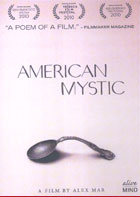
American Mystic 2010
Distributed by Kino Lorber Edu, 333 West 39 St, Suite 503, New York, NY 10018; 212-629-6880
Produced by Alex Mar, Nicholas Shumaker
Directed by Alex Mar
DVD, color, 81 min.
High School - General Adult
American Studies, Anthropology, Native American Studies, Psychology, Religious Studies, Sociology
Date Entered: 08/08/2011
Reviewed by Wendy Highby, University of Northern ColoradoAmerican Mystic is an ethnographic profile of three young adults, each following a distinctively North American religious path. Chuck lives in Rapid City, South Dakota and participates in the Sun Dance tradition of the Lakota Sioux at Thunder Valley on the Pine Ridge Reservation. Morpheus resides off the grid in a trailer in rural Santa Clara County, Northern California and follows the Feri tradition of Neopaganism or Wicca. Kublai lives in rural Rochester, New York and is studying to be a Spiritualist medium and healer. The film’s style is non-judgmental; the mystics speak for themselves. Voiceover narration by Chuck, Morpheus, and Kublai explains personal motivations and describes life trajectories as each seeks spiritual enlightenment in a non-mainstream religion. The subjects speak frankly of family background, formative experiences, and spiritual rituals and quests.
One strength of the film is its mix of the mundane and mystical. All grapple with economic realities and quotidian routines. We see Kublai baling hay, Morpheus doing housekeeping chores, and Chuck brushing his daughter’s hair. The film’s editing style emphasizes the mundane and mystical contrast. For example, a routine scene of Morpheus shaking out bed linens in front of her mobile home and describing the stress of living off the grid precedes a visually dramatic scene of Morpheus discussing her Wiccan identity and the necessity of performing “strong magic” as she ritually cleaves a pomegranate on her altar. Another strength of the film is its effective communication of potentially ineffable spiritual experiences. Night-time cinematography is employed to convey feelings of eeriness. When unable to film esoteric sacred ceremonies, Director Mar instead documents the intensive preparations, such as the building of the Lakota sweat lodge. The documentary evokes a sense of place with its fine cinematography. From the barren beauty of the South Dakota landscape to lush greenery of the Spiritualist mecca of Lily Dale in upstate New York, the viewer gets a visceral sense of each mystic’s environment.
The pedagogical uses for the film are potentially manifold. Because of the age of the subjects, the film will be particularly effective for the college classroom. The sincerity of the narratives and depth of personal disclosure create a revealingly instructive profile of each mystic. The film would be appropriate for students studying the sociology, psychology, or anthropology of religion. In particular, the segments showing spoon bending and table tipping at Lily Dale offer the opportunity to invite critical thinking and to allow equal time for skepticism in class discussions of the film.
The film lacks extensive information about the historical roots of the Lakota Sun Dance, Victor Anderson’s Feri tradition of Neopaganism/Wicca, and Spiritualism. In her commentary tracks, filmmaker Alexandra Mar explains that she did not intend to be didactic; she jokes that the film is not “PBS-style.” The instructor will need to assign background research and/or provide some context for students. The non-didactic, ethnographic style will appeal to most viewers and should provide motivation for further research. The director’s commentary is informative and would be well worth previewing by the instructor.